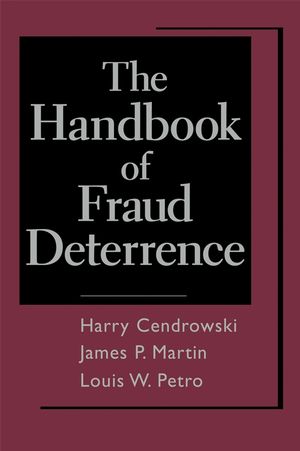The Handbook of Fraud DeterrenceISBN: 978-0-471-93134-8
Hardcover
456 pages
December 2006
 This is a Print-on-Demand title. It will be printed specifically to fill your order. Please allow an additional 10-15 days delivery time. The book is not returnable.
|
||||||
Preface.
Acknowledgments.
SECTION I.
PROFESSIONAL ENVIRONMENT OF FRAUD DETERRENCE.
1 Fraud Deterrence as a Business Management Tool.
Introduction.
Motivations for Process Improvement and Monitoring.
How the Mighty Have Fallen.
Importance of Internal Controls in Dynamic External Environments.
Environmental Change and Its Effect on the Fraud Triangle.
Where Is Bedrock for Fraud Deterrence?
Conclusion.
2 Definition of Fraud Deterrence.
Overview.
Deterrence Activities Will Affect Control Culture.
3 History of Fraud Deterrence.
Introduction.
Early Fraud Deterrence.
Modern Fraud Deterrence.
4 The Role of Professional Standards.
Introduction.
PCAOB Standards.
American Institute of Certified Public Accountants Auditing Standards.
American Institute of Certified Public Accountants Accounting
and Review Standards.
Institute of Internal Auditors Standards.
Association of Certified Fraud Examiners Standards.
Certified Fraud Deterrence Analyst—National Association of
Certified Valuation Analysts.
5 The Fraud Triangle.
Overview.
Elements.
The Fraud Triangle and Financial Reporting Fraud.
6 Motivations of Fraud Deterrence and the Transition to Investigation.
Introduction.
Motivations for Deterrence Analysis.
Transition to Investigation.
Conclusion.
7 A Fraud Deterrence Professional’s Overview of the Legal Process.
Introduction and Objectives.
Basics of Opinion Testimony and the Role of the Judiciary.
Expert Qualification Standards : When Is a Witness an “Expert”?
Admissibility versus Weight: When Is an Expert’s Opinion
and/or Testimony Admissible?
Limitations on the Scope of Expert Opinion Testimony.
Reports and Discovery Obligations.
Conclusion.
8 Human Resources Concerns.
Retaliation: The Newest Wave of Employment Litigation.
An Ounce of Prevention: Background Checks and Employment Inquiries
Under the Fair Credit Reporting Act.
Checklist for Complying with the FCRA When
Using a Third Party to Obtain “Consumer Reports."
Conclusion.
Appendix 8A.
Selected Federal Whistleblower Statutes.
Appendix 8B.
The U.S. Equal Employment Opportunity Commission.
Appendix 8C.
Disclosure to Applicant Regarding Consumer Reports.
Appendix 8D.
Disclosure to Employee Regarding Consumer Reports.
Appendix 8E.
Sample Notice of Intent to Obtain an Investigative.
Consumer Report.
Appendix 8F.
Fair Credit Reporting Act.
Appendix 8G.
Sample Disclosure of Nature and Scope of Investigative.
Consumer Report.
Appendix 8H.
Sample Pre-Adverse Action Notice.
Appendix 8I.
Sample Adverse Action Notice.
Appendix 8J.
Applicant.
Appendix 8K.
Current Employee.
SECTION II.
TOOLS OF FRAUD DETERRENCE.
9 Internal Control and Fraud Deterrence: The COSO Integrated Framework.
Background.
Control Environment.
Information and Communication.
Risk Assessment.
Control Procedures.
Monitoring.
10 Recent Corporate Governance Reforms Enacted to Deter Financial Fraud.
The Sarbanes-Oxley Act of 2002 and Related Rules and Regulations.
Introduction.
Board of Directors.
Audit Committee.
Management.
Internal Auditors.
Enforcement.
Protections for Directors and Officers.
Conclusion.
11 Generation-X Technologies and Information Assurance.
Overview.
Do We Need a Paradigm Shift in Systems Assurance and Auditing?
Generation X Enterprise Technologies: State of the Art.
Information Systems Integration: A Challenge.
Assured Information Emanates from Assured Systems.
Information Assurance: A Function of Strategic Importance.
Various Information Assurance and Control Measures.
British Standards: BS7799 and BS 7799-2:2002.
System Security Engineering Capability Maturity Model: SSE-CMM.
Conclusion.
12 The Impact of Communications Infrastructure on Fraud Detection
and Deterrence.
Introduction.
Fraud and Technology.
Communication Security Solutions.
Correlation.
13 Process and Information Validation.
Part I: Interview and Interrogation Process.
Difference between Interview and Interrogation.
Preparation and Room Setting.
Interviewer/Interrogator Demeanor.
Detecting Deception.
Conducting the Interview.
Interrogation.
Structured Approach to the Interview and Interrogation.
of a Suspect in a Fraud Investigation.
Conclusion.
Part II: Forensic Document and Handwriting Examination.
What Is a “Document”?
Forgery.
Red Flags of Document Examination.
Caution.
Red Flags of Handwriting Identification.
Suggested Reading.
14 Data Analysis and Monitoring: How Effective Data Analysis Can
Identify Fraud Risk Indicators and Promote Business Intelligence.
Introduction.
Data Basics.
Information Systems.
Generating Business Intelligence.
What to Look for in Data Analysis Technology.
Putting It All Together.
15 Reporting.
Introduction.
Function of Fraud Deterrence Reports.
Reporting on Internal Control.
Reporting in an Investigation.
Importance of Documentation.
Conclusion.
SECTION III.
APPLICATIONS OF FRAUD DETERRENCE.
16 Deterring Fraudulent Financial Reporting and Asset Misappropriation.
Introduction.
Organizational (Corporate) Culture.
Organizational (Corporate) Governance.
Internal Controls for Deterrence.
Deterrence Monitoring.
17 Fraud and the Bankruptcy Code.
Introduction.
Bankruptcy Refuge for Fraudulent Actors.
Bankruptcy Fraud.
Fraudulent Transfer Statutes.
Intentionally Fraudulent Transfers.
Constructively Fraudulent Transfers.
Application of Fraudulent Transfer Laws.
Remedies for the Recovery of Fraudulent Transfers.
Corporate Actors/Individual Liability.
Conclusion.
Appendix 17A.
Uniform Fraudulent Conveyance Act and Uniform Fraudulent Transfer Act.
Appendix 17B.
Uniform Fraudulent Conveyance Act.
Appendix 17C.
Uniform Fraudulent Transfer Act.
Appendix 17D.
18 U.S.C. §§ 152–157.
Appendix 17E.
11 U.S.C. § 548. Fraudulent Transfers and Obligations.
Appendix 17F.
11 U.S.C. § 522 Exemptions.
Appendix 17G.
11 U.S.C. § 101(31). Definitions.
18 Discovering and Preventing Fraud in Business Formation and Dissolution.
Introduction.
Fundamental Assessments.
Factors Affecting Whether the Fraud Will Succeed.
Informational Rights and Fraud.
Approval Rights and Governance.
Additional Drafting Solutions.
Minimizing the Occurrence of Fraud.
Discovery of Fraud.
Remedies.
19 Identity Theft and Privacy Protection.
Introduction.
Definition.
Development of an Epidemic.
The Outbreak and Law Enforcement.
Protecting Personal Information.
Detect Unauthorized Use.
Defend and Regain Your Identity.
Bulk Data Breaches.
The Online Frontier of Phishing and Spoofing.
Impact on Fraud Deterrence.
20 Intellectual Property.
Introduction.
How to Tell When Your Company Has Intellectual Property.
Basic Reasons for Protecting.
Routine Protection.
Policing Intellectual Property Rights.
Possible Recoveries through Litigation.
Conclusion.
21 Fraud Deterrence in the U.S. Private Equity Finance System.
Introduction.
U.S. Private Equity System and Its Governance Structure.
Foundations of a Fraud Deterrence System in Private Equity.
Adoption of Internal Control Systems within the U.S. Private Equity System.
Conclusions and Recommendations.
Glossary of Terms.
Index.



